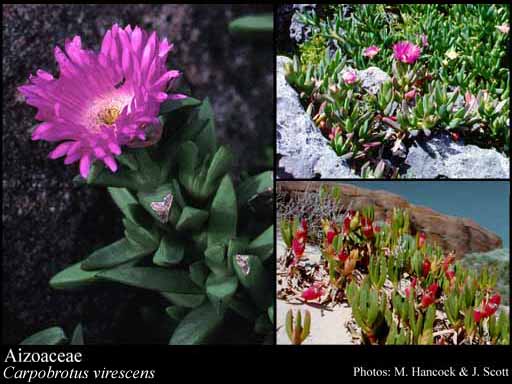- Reference
- Tekhno-Bot.Slovar 15 (1820)
- Name Status
- Current







Scientific Description
Common name. Fig-marigold Family.
Habit and leaf form. Small shrubs, or herbs. ‘Normal’ plants, or plants of very peculiar form (often reduced to a single annual pair of leaves, some forms partly subterranean with only a clear window at each leaf tip exposed above-ground). Leaves well developed (usually), or much reduced. Plants succulent. The herbs annual, or perennial; plants with a basal concentration of leaves, or with neither basal nor terminal concentrations of leaves. Xerophytic. Leaves minute to medium-sized; alternate, or opposite (or in false whorls); fleshy; imbricate to not imbricate; shortly petiolate, or subsessile, or sessile; connate, or not connate; sheathing, or non-sheathing; mostly simple; epulvinate. Leaf blades entire; often solid; one-veined, or pinnately veined, or palmately veined. Leaves with stipules, or without stipules. Vegetative buds not scaly. Leaves without a persistent basal meristem. Leaf anatomy. Urticating hairs absent. Stem anatomy. Nodes unilacunar. Secondary thickening absent, or developing from a conventional cambial ring, or anomalous; via concentric cambia (in the woodier genera,), or from a single cambial ring.
Reproductive type, pollination. Fertile flowers hermaphrodite, or functionally male and functionally female, or functionally male, or functionally female. Unisexual flowers present, or absent. Plants hermaphrodite (usually), or monoecious (rarely), or dioecious (rarely). Entomophilous (diurnal).
Inflorescence and flower features. Flowers solitary, or aggregated in ‘inflorescences’; (when aggregated) in cymes, or in heads. The terminal inflorescence unit (when flowers aggregated) cymose. Inflorescences cymes and heads. Flowers small, or medium-sized; regular; cyclic; pentacyclic to polycyclic. Free hypanthium present to absent. Hypogynous disk present, or absent. Perianth sepaline, or with distinct calyx and corolla (generally considered apetalous, but often with colourful, conspicuous staminodal ‘petals’); (1–)4–5(–20), or 20–120 (if the staminodes are interpreted as petals). Calyx (1–)4–5(–8); 1 -whorled; gamosepalous; imbricate, or valvate (rarely); unequal but not bilabiate (sometimes with two larger and three smaller members), or regular; fleshy; persistent. Corolla if considered present, 5–120 (of staminodal origin); 1–6 -whorled. Fertile stamens present, or absent (when female). Androecium (3–)4–5, or 8–10, or 15–200 (i.e. to ‘many’, by branching). Androecial members commonly branched (by dédoublement), or unbranched. Androecial sequence determinable, or not determinable. Androecial members when branched/many, maturing centrifugally; free of one another, or coherent; when coherent 3–9 - adelphous, or 1 - adelphous (the filaments basally connate into bundles, or forming a short monadelphous sheath); 1–16 -whorled (i.e to ‘many whorls’). Androecium including staminodes (nearly always), or exclusively of fertile stamens (i.e. occasionally no staminodal ‘petals’). Staminodes when present, 3–120 (usually numerous); petaloid. Stamens (1–)5, or 6–120 (i.e. to ‘many’); reduced in number relative to the adjacent perianth (rarely), or isomerous with the perianth, or diplostemonous to polystemonous; filantherous. Anthers dehiscing via longitudinal slits; introrse; tetrasporangiate. Pollen shed as single grains. Fertile gynoecium present, or absent (in male flowers). Gynoecium (1–)2–5(–20) carpelled. The pistil (1–)2–5(–20) celled. Gynoecium syncarpous (rarely pseudomonomerous); synovarious to synstylovarious; superior to inferior. Ovary unilocular, or plurilocular; (1–)2–5(–20) locular. Gynoecium non-stylate to stylate. Styles 1–20 (or absent); apical, or apical to lateral (excentric). Stigmas (1–)2–5(–20); wet type, or dry type; papillate; Group II type, or Group III type. Placentation when unilocular (i.e., rarely) parietal; when plurilocular, axile (typically), or basal (rarely), or parietal (Mesembryanthemum sensu lato). Ovules (1–)50 per locule; arillate, or non-arillate; anatropous, or campylotropous.
Fruit and seed features. Fruit fleshy (rarely), or non-fleshy; dehiscent, or indehiscent; a capsule, or a berry. Capsules loculicidal, or septicidal, or circumscissile, or valvular. Seeds non-endospermic. Perisperm present (mealy). Seeds with starch. Embryo well differentiated. Cotyledons 2. Embryo achlorophyllous (2/2); curved. Seedling. Germination phanerocotylar.
Physiology, biochemistry. Aluminium accumulation not found. Plants commonly accumulating free oxalates. Photosynthetic pathway: C4, or CAM.
Geography, cytology, number of species. World distribution: chiefly southern Africa, but also tropical Africa and Asia, Australia, California, South America. X = 8, 9. 1100 species.
Economic uses, etc. Edible fruit from Mesembryanthemum edule (Hottentot fig).